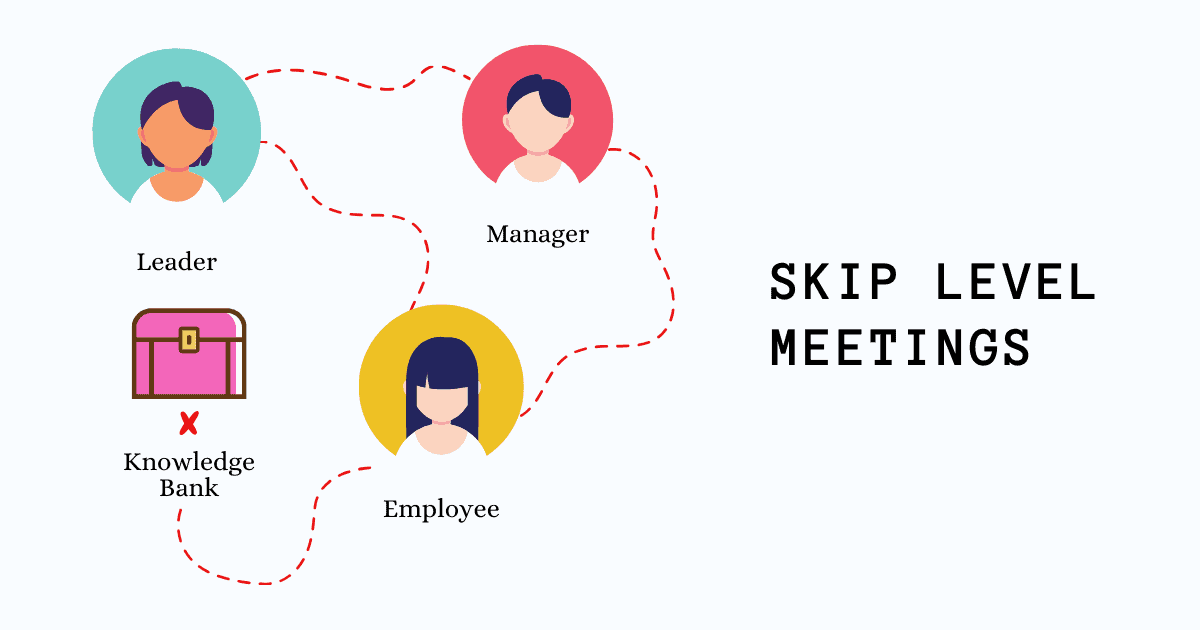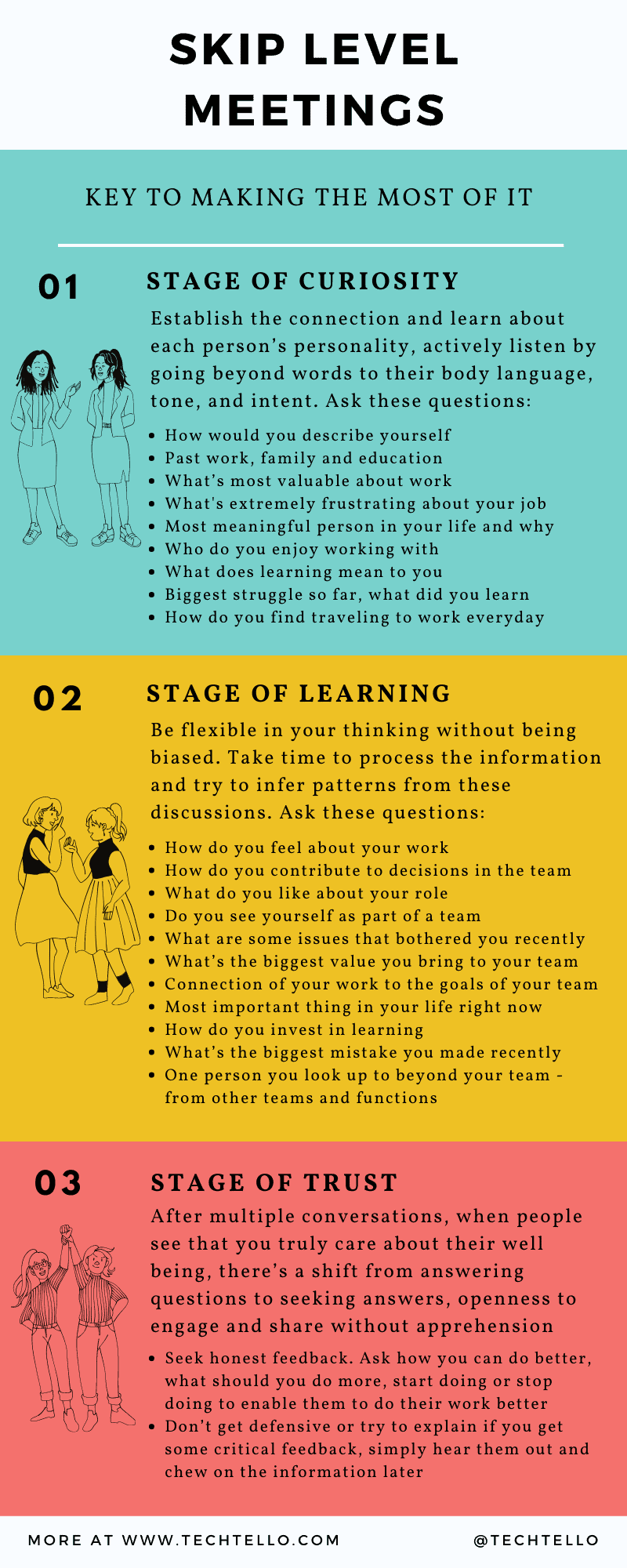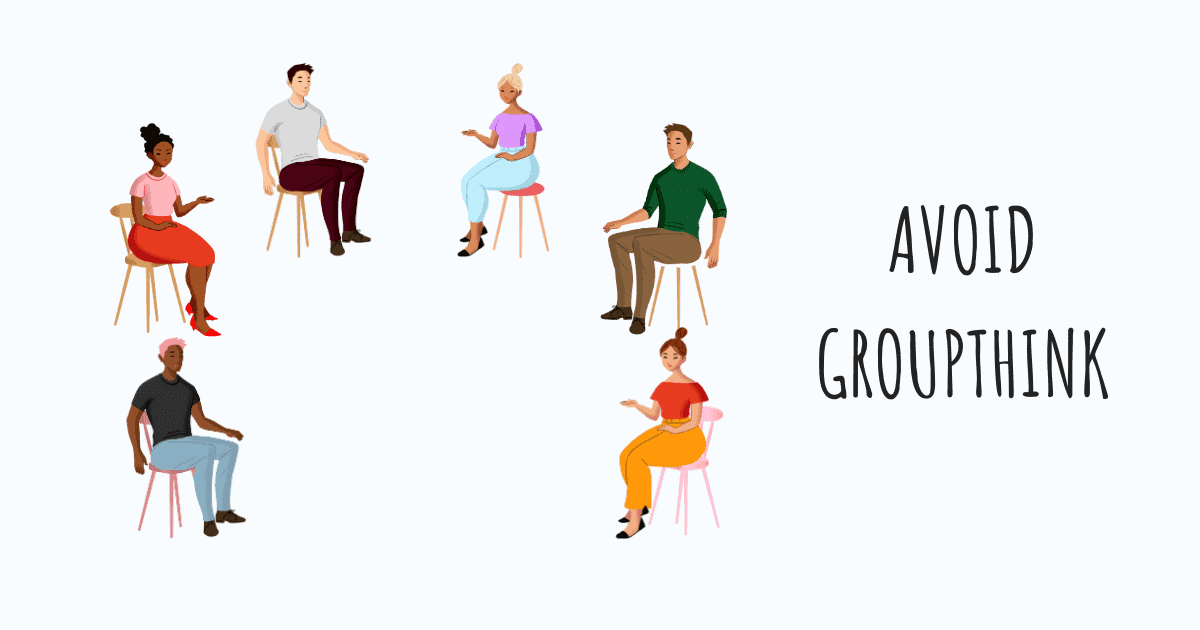Skip-Level Meetings: Uncovering Your Organisation’s Reality

As a leader of an organisation, the question “what needs attention” was always top of my mind. I realised that without taking real inputs from people in the organisation, any decisions I make and the direction I provide will be nothing but my own biased view of what people want, not what they need.
Looking down from 10000 ft above the ground, you may see the greenery of the forests, ice-covered mountains, beautiful terrains, and vastness of the oceans. It’s only when you get to the ground, the rough patches start to surface. Once you notice the new reality, you can shift your perspective to align with the real world.
I realised that this is so true at work too. If I let hierarchy magnify the distance that I have from my people especially those who do not report to me, I can never learn about the issues that impact people on a day-to-day basis. Are they looking for more empowerment, recognition, engagement, growth or are they happy with the way things are? How are they learning?
Without diving deep into people’s minds, I can never develop the intelligence and perspective required to stay close to reality. So I decided to go to the source, hear it from their own mouth without any presumptions.
Before I share my learnings from skip-level meetings, you may be wondering why I could not trust my direct reports to provide me this information. What’s truly so valuable about skip-level meetings that I had to skip my direct reports and speak to the people reporting to them. Put another way, why was it worth my time?
What value do skip-level meetings provide?

If I wanted to create a map for my organisation that can help people determine which paths to avoid and which ones to take to be successful in the long run, I had two options:
Option 1 – Design all possible paths and subject them to my interpretation based on my beliefs and assumptions. Aside from being highly complex, it will be limited to my circle of competence and those of my direct reports
Option 2 – Draw on the collective knowledge of all the people in my org and overlay their knowledge with my experience to design this map
Aside from the fact that option 2 helps unearth real problems, it’s very effective in finding patterns that either enable people to move forward or hold them back. If I could access the personal map every person uses to navigate the organisation, I could design a strategy that enables everyone to be more effective in their work.
As Peter Drucker said in his book, The Effective Executive
The more aware we are of our basic paradigms, maps, or assumptions, and the extent to which we have been influenced by our experience, the more we can take responsibility for those paradigms, examine them, test them against reality, listen to others and be open to their perceptions, thereby getting a larger picture and a far more objective view
In any organisation, all strategies and tactics are useless without clarity on what we are trying to achieve and why it’s the right direction for the organisation and its people.
Accessing this map is fundamental to uncover hidden treasures and design a long term strategy that’s rooted in the collective power of minds. Each individual MAP gave me access to information that could be put to use to draw patterns of behaviour and thinking in the organisation.
Notice the idea of meeting my indirect reports is not to spy on people who report to me. Though done right, it can also be used to draw valuable insights about how they feel about their manager.
Make an attempt to inquire about their manager directly and they will never share true feedback. While learning about their M-mindset, A-awareness and P-priorities (their personal map) helps get below the surface to uncover reality.
Another positive side-effect of meeting them face-to-face that I didn’t realise at the time was the connection and the trust that it established. Knowing each person by name, learning about what they value, and how they are doing helped me establish a deeper bond with each one of them. I truly found value in meeting every single one of them and looked forward to each such interaction.
Get your FREE copy of the Skip Level Meeting Template at the end of this article.
MAP framework for effective skip-level meetings

Asking the right questions and giving an opportunity to the other person to speak is at the heart of every useful conversation.
L. David Marquet suggests in his book, Turn The Ship Around
If you walk about your organization talking to people, I’d suggest that you be as curious as possible. As with a good dinner table conversationalist, one question should naturally lead to another. The time to be questioning or even critical is after trust has been established.
With that in mind, let’s understand what this framework provides:
M – Mindset
Mindset reflects their feelings. These feelings provide indirect answers to a lot of questions that are otherwise very difficult to analyse
- Do they feel fearful or safe to take risks
- Are they empowered to make decisions or seek approval for every action
- Do they get the required support that helps them move forward or find themselves struggling every step of the way
- Do they feel recognised for their work or ignored without appreciation
- How do they feel being part of their team and this organisation
- Do they find the culture of the company conducive to learning or restrictive in growth
- How do they perceive fairness in the organisation
Once you understand how they feel without judgement or opinion, you can connect their mindset to levels of awareness, which takes us to the next step in the map.
A – Awareness
Awareness reflects their understanding of the organisation and their relationship to it. It offers key insights into the awareness level of the person
- Are they aware of their personal goals
- Do they understand their goals as a team and how are they relevant
- Can they find a connection of their team to the vision and mission of the org
- How do they view the success of the company and their personal success
- Do they see how their work is aligned with the direction of the company
- What do they feel about other teams and functions
- Do they find value in engaging outside their teams
- How can they contribute beyond their assigned responsibilities
Understanding this connection of an individual to the larger purpose of the organisation opens the gateway to finding their priorities.
P – Priorities
Priorities of a person reflect what they truly care about. Every person has different core needs at work that shapes how they perceive information and experience the world around them. It’s how they behave, decide, and act in the workplace. Learning about their priorities requires understanding
- What’s top of their mind
- What do they find valuable in their work
- How do they react to new information or changes around them
- At this moment, do they need growth, stability or flexibility
This map serves as a mental model to help connect the dots to what’s working for people and what prevents them from doing their best work.
Now that I had a framework in place to derive value from skip-level meetings, I needed to put it into practice. I had to determine the right frequency that will add value to our conversations.
Skip Level Meeting Questions + Template
Use these skip level meeting questions with indirect reports to bridge the gap, get a better perspective on how things are going and maintain a human connection with each person on your team.
How often do you need skip-level meetings?
If you are a director, VP, or someone in a CXO position, you may have a few direct reports (other managers) with a large number of people reporting to them.
Depending on the number of indirect reports, balance out the schedule such that it’s not too frequent nor too far apart.
I preferred meeting everyone once a quarter for 30 mins. You can do it for 45-60 mins as well depending on your comfort level and change it as you go once the momentum is established.
Assume you have 80 indirect reports and you choose to meet them once a quarter for 30-45 mins, all that’s needed is 5 hours each week on your calendar, which is nothing compared to the value it provides in the long run.
With framework and frequency determined, the next step is to start on the right note.
How to start skip-level meetings?
There are 2 key elements of putting your intent to action:
1 – Messaging it right
If the process of doing skip-level meetings is new to your organisation, it’s extremely important to inform your managers about your intent to meet their direct reports and explain what it means to you and them.
Sharing your perspective on how it helps the organisation sets the right tone for the purpose of the discussion. Keeping them in the loop on this decision not only builds trust, it avoids the confusion and anxiety that might come from not knowing.
2 – Scheduling it
It doesn’t matter which person you pick to start, but it’s important to schedule it for every single member of your org. The information that you are meeting indirect reports will spread faster than you can imagine. Try to do it across teams picking people from different roles and backgrounds every week to avoid people feeling left out or biased.
The invite should be thoughtful and precise with the objective of the meeting as an intent to collaborate instead of a one-sided conversation.
From my experience, a recurring invite from the beginning also establishes your seriousness and commitment to do it right and not make people consider it as a one-off thing.
How to make the most of skip-level meetings?
I observed myself going through 3 stages of skip-level meetings. The time in each stage varied from person-to-person depending on how they viewed these meetings and the effort they were willing to put in to add value to the conversation.
To be honest, not every interaction was super useful and some were quite draining due to the drama in the conversation. However, people willing to engage in a meaningful dialogue provided value that far outweighed some little episodes of emotional stress along the way.
To make the most of skip-level meetings, it’s important to observe how your relationship with each person goes through these 3 stages.
As skip-level meetings are far apart, typically a few months, the context from the previous meeting brings in a ton of value to the current discussion. I preferred taking notes along the way to help me remember key points from the discussion for our next meeting. It’s also very interesting to notice how their map (mindset, awareness, priorities) has shifted in the last few months trending in the positive or negative direction.
1. Stage of curiosity
Each person has a different personality. Some are quiet, others loud and expressive. Some struggle with words, while others can impress you with it. Some are honest and straightforward, while others will try to exaggerate or blow a situation out of proportion. Some enjoy their work without the need for attention while others do work to get the necessary attention.
Understanding each person in terms of their personality is an important element to make the most out of these discussions and form a balanced view of their thoughts and opinions.
Always start with yourself. Share a bit about your passions, what motivates you, your background, what brought you to this company, and any other personal details that might be relevant for the person to feel comfortable.
To establish the connection and learn about each person’s personality, actively listen by going beyond words to their body language, tone, and intent. These non-verbal cues will provide invaluable information to understand each person better. Some good questions to ask in this stage:
- How would you describe yourself
- I am curious to know about your past work, family and education
- What’s most valuable about work
- What do you hate or find extremely frustrating about your job
- Who is the most meaningful person in your life and why
- Who do you enjoy working with
- What does learning mean to you
- What’s been your biggest struggle so far and what did you learn from it
- How do you find traveling to work everyday
With a peek into their world, it’s the right time to learn more about their maps.
2. Stage of learning
Getting people to open up is a really tricky job. It will require you to play a little bit of a detective and push the right levers to get to the underlying message.
Be flexible in your thinking without being biased or quick to jump to conclusions about what you hear. Take time to process the information and try to infer patterns from these discussions. Key is to ask some great follow-up questions to some of these initial questions:
- How do you feel about your work – positive, negative or neutral
- How do you see yourself contributing to decisions in the team
- What do you like about your role and the organisation
- Do you see yourself as part of a team
- What are some issues that bothered you recently
- What’s the biggest value you bring to your team
- How do you see the connection of your work to the goals of your team and the mission of your org
- What’s the most important thing in your life right now that you value and want to prioritise. What are you willing to trade-off to make it happen
- How do you invest in learning? Do you find company’s environment supportive in enabling it
- What’s the biggest mistake you made recently and what did you learn from it? How did you feel in the moment – criticised, supportive, fearful, empowered
- One person you look up to beyond your team – from other teams and functions
While there are hundreds of questions on this theme, I guess you get the idea of the kind of questions that can get you started. Don’t scratch the surface, try to go as deep as possible without pushing too hard. Know when it’s time to back off.
3. Stage of trust
After multiple conversations, when people see that you truly care about their well being, there’s a shift from answering questions to seeking answers, openness to engage and share without apprehension.
As trust starts to emerge and you sense a level of comfort with your indirect report, it’s time to seek some honest feedback. Ask about how you can do better, what should you do more, start doing or stop doing to enable them to do their work better.
They may have nothing to say the first time around. Reframe it, ask again and be silent until you get them to speak up. Silence is a very powerful tool at your disposal. Use it as much as possible to give a chance to the other person to express.
Don’t get defensive or try to explain if you get some critical feedback, simply hear them out and chew on the information later.
Recommended Reading
Free Skip Level Meeting Template
Get this skip level meeting template for free that you can put to use right away. It has all the questions laid out to guide you to an effective conversation with your indirect reports.

SIGN UP TO GET ACCESS
FREE DOWNLOAD
Skip-level meetings done right can be a powerhouse of useful information, a chance to connect and care, learn and grow, and do the right thing for your organisation and its people. It will be the best investment of your time as a leader.
Do you see a value in skip-level meetings? What are your learnings from them? Write to me or share your thoughts in the comments below.






























